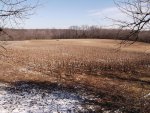Well wildlife damage in crops is a complicated issue. First you have to look at what animals eat. Coon don't eat much leafy vegetation, they prefer grain and fruit. So coon won't bother corn till there's kernels on the cob. Coon also don't eat hay or wheat and I've never seen any evidence of coon damaging soybeans. Their damage tends to be worse close to woods and streams.
Groundhogs eat leafy vegetation, so they are bad in hay and soybeans. They can be terrible on melons and pumpkins, the little bastards like to take ONE bite out of each. They don't seem to affect corn after it gets knee high. One thing about groundhogs is they tend to keep close to their holes so the damage is localized, not much worry of the groundhogs crossing 2 properties to get to my fields. Since I can kill unlimited numbers of groundhogs pretty much 24/7 it's my fault if they are a problem.
Now deer eat both vegetation and grain. Deer browse/graze on corn and beans from emergence. When a deer eats the top of a small corn plant it grows funny and usually doesn't produce a normal if any ear. Deer also seem to like silk and will bite off the ends of growing ears. The trend in corn to set the ears higher, walk through a field and take note of ear placement, shoulder high isn't unusual. At one time I would have agreed that deer didn't knock much corn down but that isn't a hard and fast rule. A deer will have a hard time eating ears 4-5 feet high without pulling down the stalk.
Deer are 6-8-10 times larger than coon and groundhogs so they need a larger volume of feed and they need to eat 365 days a year(groundhogs hibernate) so they can bother late standing crops, winter wheat, hay and fruit trees in the winter. Deer being herd animals when deer are in a field usually there's more then 1. Deer will travel to get to a preferred food source, at times miles.
Finally if there is a complaint to the ODNR about damage the WO is supposed to come out an inspect the damage. Even if the farmer doesn't know the difference I'd hope a WO would have a better idea what caused it.



 :screwy:
:screwy:


